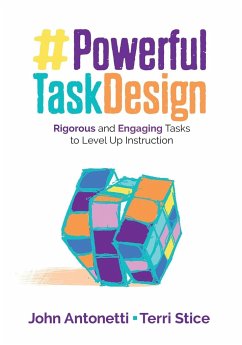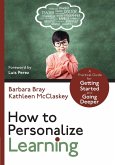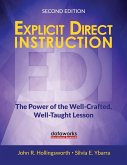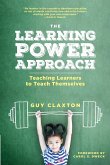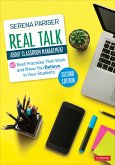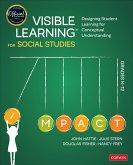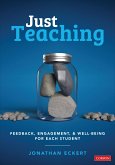John V. Antonetti, Terri Ann Stice
Powerful Task Design
Rigorous and Engaging Tasks to Level Up Instruction
John V. Antonetti, Terri Ann Stice
Powerful Task Design
Rigorous and Engaging Tasks to Level Up Instruction
- Broschiertes Buch
- Merkliste
- Auf die Merkliste
- Bewerten Bewerten
- Teilen
- Produkt teilen
- Produkterinnerung
- Produkterinnerung
Applicable to educators across all disciplines and grade levels, this book provides the tools to analyze, design, and refine cognitively engaging tasks of learning.
Andere Kunden interessierten sich auch für
![How to Personalize Learning How to Personalize Learning]() Barbara A. BrayHow to Personalize Learning41,99 €
Barbara A. BrayHow to Personalize Learning41,99 €![Explicit Direct Instruction (EDI) Explicit Direct Instruction (EDI)]() John R. Hollingsworth (DataWORKS Educational Research)Explicit Direct Instruction (EDI)40,99 €
John R. Hollingsworth (DataWORKS Educational Research)Explicit Direct Instruction (EDI)40,99 €![The Learning Power Approach The Learning Power Approach]() Guy ClaxtonThe Learning Power Approach32,99 €
Guy ClaxtonThe Learning Power Approach32,99 €![Real Talk About Classroom Management Real Talk About Classroom Management]() Serena PariserReal Talk About Classroom Management33,99 €
Serena PariserReal Talk About Classroom Management33,99 €![Real Talk About Classroom Management Real Talk About Classroom Management]() Serena PariserReal Talk About Classroom Management33,99 €
Serena PariserReal Talk About Classroom Management33,99 €![Visible Learning for Social Studies, Grades K-12 Visible Learning for Social Studies, Grades K-12]() John Hattie (Australia The University of Melbourne)Visible Learning for Social Studies, Grades K-1249,99 €
John Hattie (Australia The University of Melbourne)Visible Learning for Social Studies, Grades K-1249,99 €![Just Teaching Just Teaching]() Jonathan EckertJust Teaching42,99 €
Jonathan EckertJust Teaching42,99 €-
-
-
Applicable to educators across all disciplines and grade levels, this book provides the tools to analyze, design, and refine cognitively engaging tasks of learning.
Hinweis: Dieser Artikel kann nur an eine deutsche Lieferadresse ausgeliefert werden.
Hinweis: Dieser Artikel kann nur an eine deutsche Lieferadresse ausgeliefert werden.
Produktdetails
- Produktdetails
- Corwin Teaching Essentials
- Verlag: SAGE Publications Inc
- Seitenzahl: 218
- Erscheinungstermin: 21. März 2018
- Englisch
- Abmessung: 254mm x 178mm x 12mm
- Gewicht: 416g
- ISBN-13: 9781506399140
- ISBN-10: 1506399142
- Artikelnr.: 49394136
- Herstellerkennzeichnung
- Libri GmbH
- Europaallee 1
- 36244 Bad Hersfeld
- gpsr@libri.de
- Corwin Teaching Essentials
- Verlag: SAGE Publications Inc
- Seitenzahl: 218
- Erscheinungstermin: 21. März 2018
- Englisch
- Abmessung: 254mm x 178mm x 12mm
- Gewicht: 416g
- ISBN-13: 9781506399140
- ISBN-10: 1506399142
- Artikelnr.: 49394136
- Herstellerkennzeichnung
- Libri GmbH
- Europaallee 1
- 36244 Bad Hersfeld
- gpsr@libri.de
John Antonetti is a learner. He has had the great fortune to visit classrooms throughout North America in an effort to answer the question "What truly engages learners?" From thousands of students in pre-K through Graduate School, John has learned the three facets of powerful learning tasks--intellectual, academic, and emotional engagement. John Antonetti is a teacher. He has taught A.P Chemistry and Kindergarten and most grades in between in his home state of Arkansas. Once described by Larry Lezotte as a "teacher's teacher," Mr. Antonetti works with schools across the country and Canada on student engagement, writing, rigor and relevance, powerful task design, and high-yield best practices. As the former Director of Curriculum in the Sheridan School District in Arkansas, he took what he learned in his home district and developed strategies and protocols that work across all school types. He has partnered with five school districts that were awarded the nationally-recognized Broad Prize for Urban Education. While hands-on work in schools is his passion, John is also a highly-sought keynote speaker. His humor and parables are recognized by teachers, administrators, and parents as relevant examples of the power of teachers. Antonetti is the author of the book, Writing as a Measure and Model of Thinking which utilizes the engagement cube and practical tools to increase student thinking in all subject areas. With his late business partner and friend, Jim Garver, John co-authored the ASCD best-seller 17,000 Classroom Visits Can't be Wrong: Strategies that Engage Students, Promote Active Learning, and Boost Achievement. Whether he's on the Kinder carpet or in front of 4000 teachers at an international conference, Antonetti continues to learn. ?Terri Stice transitioned to education 23 years ago when she accepted a position as a preschool teacher. Shortly thereafter she moved to K-12 public schools where she truly found her passion, sharing her technical expertise with students, teachers, and administrators both from the classroom and as District Technology Coordinator. In July 2000, she joined the GRREC staff as Technology Coordinator and in 2005 her position was transformed into Director of Instructional Technology and Support Services. During her tenure at GRREC she has been selected as a National Professional Development provider for Discovery Education, and The Verizon Foundation. Terri has received the honor of being named an Apple Distinguished Educator, an Apple Certified Foundations Field Trainer, a Google Certified Teacher, a School Culture Assessment Trainer and a Kentucky Colonel. She has earned a Master of Science degree in Instructional Media Education, and a Bachelor of Science degree in Education.
Acknowledgments
About the Authors
Introduction: The Power of the Task
1. The Work of School
A Task Is a Task
Task Predicts Performance
The Design Components of a Task
Technology in a Working Model, or When Terri Met Sally (Ahem, John)
The Powerful Task Rubric for Designing Student Work
2. Analyzing Learning With the Powerful Task Rubric
One Content, Five Tasks
Where Was the Power?
3. The Power of Engagement
The Qualities of Engagement
Interaction as Engagement
A Task Is Powered Up
4. The Power of Academic Strategies
It Starts on the Playground
Strategies of Personal Response
Identifying Similarities and Differences
Summarizing and Note-Making
Note-Taking Becomes Note-Making
Reflection in Note-Making
Nonlinguistic Representations
Generating and Testing Hypotheses
Reflection and Closure
5. The Power of the Question
Where Does a Question Come From?
See-Think-Wonder
Where Do Teacher Questions Come From?
How to Open a Question
Technology and Questions
6. Engaged in What? The Power of Cognition
Cognitive Demand
Learning Through Accepting Meaning
Thinking and Making Meaning
Making Meaning on Top of Meaning
Sliding Across the Cognitive Continua: A Hierarchy, Not a Sequence
Math Cognition and the Task Rubric
Encoding and Memory
7. Power Up: Using the Diagnostic Instrument to Analyze Learning
The Diagnostic Instrument to Analyze Learning
Premises and Research Behind the DIAL
Using the DIAL
Three DIAL Implementations
Tips for the Tool
8. Putting It All Together
Final Thoughts
References
Index
About the Authors
Introduction: The Power of the Task
1. The Work of School
A Task Is a Task
Task Predicts Performance
The Design Components of a Task
Technology in a Working Model, or When Terri Met Sally (Ahem, John)
The Powerful Task Rubric for Designing Student Work
2. Analyzing Learning With the Powerful Task Rubric
One Content, Five Tasks
Where Was the Power?
3. The Power of Engagement
The Qualities of Engagement
Interaction as Engagement
A Task Is Powered Up
4. The Power of Academic Strategies
It Starts on the Playground
Strategies of Personal Response
Identifying Similarities and Differences
Summarizing and Note-Making
Note-Taking Becomes Note-Making
Reflection in Note-Making
Nonlinguistic Representations
Generating and Testing Hypotheses
Reflection and Closure
5. The Power of the Question
Where Does a Question Come From?
See-Think-Wonder
Where Do Teacher Questions Come From?
How to Open a Question
Technology and Questions
6. Engaged in What? The Power of Cognition
Cognitive Demand
Learning Through Accepting Meaning
Thinking and Making Meaning
Making Meaning on Top of Meaning
Sliding Across the Cognitive Continua: A Hierarchy, Not a Sequence
Math Cognition and the Task Rubric
Encoding and Memory
7. Power Up: Using the Diagnostic Instrument to Analyze Learning
The Diagnostic Instrument to Analyze Learning
Premises and Research Behind the DIAL
Using the DIAL
Three DIAL Implementations
Tips for the Tool
8. Putting It All Together
Final Thoughts
References
Index
Acknowledgments
About the Authors
Introduction: The Power of the Task
1. The Work of School
A Task Is a Task
Task Predicts Performance
The Design Components of a Task
Technology in a Working Model, or When Terri Met Sally (Ahem, John)
The Powerful Task Rubric for Designing Student Work
2. Analyzing Learning With the Powerful Task Rubric
One Content, Five Tasks
Where Was the Power?
3. The Power of Engagement
The Qualities of Engagement
Interaction as Engagement
A Task Is Powered Up
4. The Power of Academic Strategies
It Starts on the Playground
Strategies of Personal Response
Identifying Similarities and Differences
Summarizing and Note-Making
Note-Taking Becomes Note-Making
Reflection in Note-Making
Nonlinguistic Representations
Generating and Testing Hypotheses
Reflection and Closure
5. The Power of the Question
Where Does a Question Come From?
See-Think-Wonder
Where Do Teacher Questions Come From?
How to Open a Question
Technology and Questions
6. Engaged in What? The Power of Cognition
Cognitive Demand
Learning Through Accepting Meaning
Thinking and Making Meaning
Making Meaning on Top of Meaning
Sliding Across the Cognitive Continua: A Hierarchy, Not a Sequence
Math Cognition and the Task Rubric
Encoding and Memory
7. Power Up: Using the Diagnostic Instrument to Analyze Learning
The Diagnostic Instrument to Analyze Learning
Premises and Research Behind the DIAL
Using the DIAL
Three DIAL Implementations
Tips for the Tool
8. Putting It All Together
Final Thoughts
References
Index
About the Authors
Introduction: The Power of the Task
1. The Work of School
A Task Is a Task
Task Predicts Performance
The Design Components of a Task
Technology in a Working Model, or When Terri Met Sally (Ahem, John)
The Powerful Task Rubric for Designing Student Work
2. Analyzing Learning With the Powerful Task Rubric
One Content, Five Tasks
Where Was the Power?
3. The Power of Engagement
The Qualities of Engagement
Interaction as Engagement
A Task Is Powered Up
4. The Power of Academic Strategies
It Starts on the Playground
Strategies of Personal Response
Identifying Similarities and Differences
Summarizing and Note-Making
Note-Taking Becomes Note-Making
Reflection in Note-Making
Nonlinguistic Representations
Generating and Testing Hypotheses
Reflection and Closure
5. The Power of the Question
Where Does a Question Come From?
See-Think-Wonder
Where Do Teacher Questions Come From?
How to Open a Question
Technology and Questions
6. Engaged in What? The Power of Cognition
Cognitive Demand
Learning Through Accepting Meaning
Thinking and Making Meaning
Making Meaning on Top of Meaning
Sliding Across the Cognitive Continua: A Hierarchy, Not a Sequence
Math Cognition and the Task Rubric
Encoding and Memory
7. Power Up: Using the Diagnostic Instrument to Analyze Learning
The Diagnostic Instrument to Analyze Learning
Premises and Research Behind the DIAL
Using the DIAL
Three DIAL Implementations
Tips for the Tool
8. Putting It All Together
Final Thoughts
References
Index

